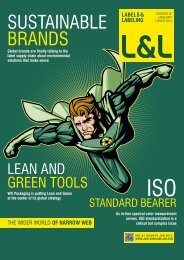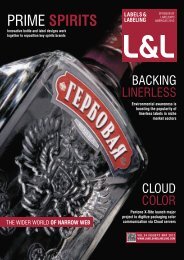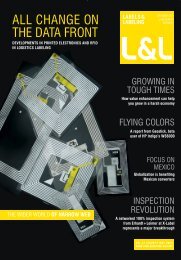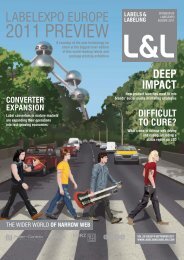SELL
Download - Labels & Labeling
Download - Labels & Labeling
- No tags were found...
You also want an ePaper? Increase the reach of your titles
YUMPU automatically turns print PDFs into web optimized ePapers that Google loves.
68 | L&L<br />
With advanced scientific research and<br />
development, ACF has decreased the<br />
Eucalyptus plantation cycle to six years on<br />
the first planting rotation, and has developed<br />
nurturing techniques to grow harvestable trees<br />
in as few as four years in a subsequent rotation<br />
using coppicing, a traditional form of forest<br />
management whereby new trees are grown<br />
from the remaining trunk of a cut down tree.<br />
In total, ACF has the capacity to produce five<br />
million tons of wood annually.<br />
The Hainan Central Nursery is where the<br />
magic happens. Scientists closely monitor the<br />
development of cross pollinated tissues and<br />
seeds, led by Dr Wending Huang, deputy CEO<br />
of APP China Forestry, who holds a degree<br />
from China’s Nanjing Forestry University and<br />
a PhD in forestry ecology from the University<br />
of Helsinki. Employees can be seen analyzing<br />
the tissue cultures, growing them into cuttings<br />
ready to go for planting in the nursery’s 70<br />
hectares of land. This location is capable of<br />
producing 100 million cuttings each year,<br />
and a smaller ACF nursery, Guangxi Central<br />
Nursery, can produce 90 million cuttings<br />
annually on 65 hectares. ACF cultivates<br />
mostly Eucalyptus trees and also Acacia,<br />
Pinus and Poplar.<br />
The company explains that the lands the<br />
government approves for timber growth are<br />
typically undesirable for other agricultural use,<br />
like sandy areas and low rainfall regions. The<br />
firm must then go through a multi-step process<br />
of engaging the landowners, producing a land<br />
audit and submitting a request for approval<br />
(that can be rejected). If the government<br />
agrees to the proposal, and believes that the<br />
locals will also benefit, a land tenure contract is<br />
signed between the government and ACF.<br />
All land in China is owned by the State, or<br />
what it calls rural collectives, and plantations<br />
are managed either by renting land from the<br />
LABELS&LABELING<br />
collectives in a profit sharing scheme,<br />
or through a joint venture with the<br />
landowners.<br />
The organization and planning for<br />
the development of these plantations<br />
is highly complex. SAP software<br />
creates profiles of each planting<br />
zone to ensure proper raw materials<br />
management, planting, harvesting,<br />
road construction and maintenance,<br />
and to assist the company in better<br />
understanding the terrain so the best<br />
saplings with the right resistance are<br />
planted in the most beneficial areas.<br />
This software has allowed ACF<br />
to establish its own chain of<br />
custody system to ensure only its<br />
bio-engineered trees are harvested<br />
and delivered to the mills. Tracking<br />
systems map out best delivery routes.<br />
Pre-harvest inventory measurements<br />
are taken and trees are stacked and<br />
locked on trucks for verifiable delivery.<br />
Once delivered to the mill, the weight is<br />
crosschecked with site records and the<br />
delivery mileage is verified.<br />
ACF regularly performs internal<br />
and external audits of its systems,<br />
such as runoff and land mineral<br />
measurements, to ensure conformance<br />
to national environment regulations,<br />
which, contrary to popular belief, are<br />
comparable to European standards.<br />
This plantation-based fiber supply is<br />
critical to the sustainable evolution of<br />
China’s domestic paper market. Yet<br />
the amount of fiber currently produced<br />
by ACF does not meet the capacity<br />
requirements of APP’s large pulping<br />
facilities. And this well-managed timber<br />
resource comes at a higher cost than<br />
international averages.<br />
HAINAN JINHAI PULP<br />
AND PAPER PLANT<br />
The vast Hainan Jinhai Pulp and<br />
Paper plant, located in the Yangpu<br />
Economic Development Zone, is a<br />
key part of APP China’s integrated<br />
pulp and paper production strategy.<br />
This facility is also located on Hainan<br />
Island off the southwest tip of China,<br />
spreading a whopping 400 hectares, or<br />
8,000 acres. Six thousand employees<br />
run the nation’s largest pulp line<br />
and a paper line which produce 1.2<br />
million tons of pulp and 900,000 tons<br />
of paper each year. The first phase<br />
of development saw APP invest<br />
10.5 billion RMB in 2005 to build a<br />
bleached eucalyptus kraft pulp line<br />
with an annual capacity of one million<br />
tons. The line requires both short fiber<br />
wood – like the hard wood Eucalyptus<br />
and Acacia trees found domestically<br />
– and long fibers only found outside<br />
the country, which means making the<br />
plant remains dependent on oversees<br />
pulp producers in Canada and Brazil to<br />
make quality fine paper.<br />
Last September, the company<br />
commissioned a 13.6 billion RMB Voith<br />
fine paper machine with an annual<br />
production capacity of 1.6 million tons.<br />
The behemoth is the largest in the world,<br />
428.18 meters long (half a kilometer),<br />
10.96 m wide and housed in a building<br />
660m long. It takes 20 minutes to walk
















